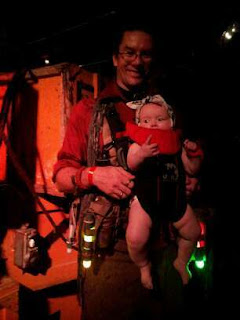 I'm going to divert from my usual line of reviews to cover something a bit different. I'm a firm believer in salvage and I hate to see useful resources going to waste. These containers are case in point. The facility I work at receives items shipped internationally and interstate regularly, and due to the sensitive nature of the items, regulations require a certain level of regulation packaging. The items are typically sealed in a small plastic box, wrapped in bubble-wrap and placed in one of these containers, which is shipped in its own stiff cardboard box. The containers are called Pathopaks and they are produced by DGP Group, a division of Intelsius. The thing is, after they arrive at my facility, and the items taken out and processed, the containers, box cardboard and the jar, get tossed into the recycling as waste. This would just not do, because these containers are ACE. We receive them in two sizes, 1L and 2L. Let's start with the 1L container's features.
I'm going to divert from my usual line of reviews to cover something a bit different. I'm a firm believer in salvage and I hate to see useful resources going to waste. These containers are case in point. The facility I work at receives items shipped internationally and interstate regularly, and due to the sensitive nature of the items, regulations require a certain level of regulation packaging. The items are typically sealed in a small plastic box, wrapped in bubble-wrap and placed in one of these containers, which is shipped in its own stiff cardboard box. The containers are called Pathopaks and they are produced by DGP Group, a division of Intelsius. The thing is, after they arrive at my facility, and the items taken out and processed, the containers, box cardboard and the jar, get tossed into the recycling as waste. This would just not do, because these containers are ACE. We receive them in two sizes, 1L and 2L. Let's start with the 1L container's features.
 The blue lidded 1L containers are the rarer of the two kinds, at my facility, I have no idea why, as in my opinion the items shipped are no where near big enough to warrant even that big a container individually, even with copious bubble-wrap. But, that's how it goes. The containers are a high density SPI Resin 5 PP Polypropylene 95kPa pressure vessel, which can be frozen, and stored at 37oC (important to know, in my facility). They are solvent, acid and base resistant and are rated for biological substance containment. The lid has a robust thread, and a silicone o-ring seal and the overall internal size of the 1L container is 88x170mm and they weigh 240g.
The blue lidded 1L containers are the rarer of the two kinds, at my facility, I have no idea why, as in my opinion the items shipped are no where near big enough to warrant even that big a container individually, even with copious bubble-wrap. But, that's how it goes. The containers are a high density SPI Resin 5 PP Polypropylene 95kPa pressure vessel, which can be frozen, and stored at 37oC (important to know, in my facility). They are solvent, acid and base resistant and are rated for biological substance containment. The lid has a robust thread, and a silicone o-ring seal and the overall internal size of the 1L container is 88x170mm and they weigh 240g.  The orange topped containers are the 2L version, which we receive many more of. They are 125x170mm internally and weigh 450g. All the other features are the same, simply scaled up. Why would I want them? Well, after being emptied, I collect them, and give them all a liberal disinfection with 70% ethanol, which is an effective anti-microbial. I allow them to air dry, and take them home giving them a further dish-washer cleanse and -bam- I have a robust and standardized, sealable storage container.
The orange topped containers are the 2L version, which we receive many more of. They are 125x170mm internally and weigh 450g. All the other features are the same, simply scaled up. Why would I want them? Well, after being emptied, I collect them, and give them all a liberal disinfection with 70% ethanol, which is an effective anti-microbial. I allow them to air dry, and take them home giving them a further dish-washer cleanse and -bam- I have a robust and standardized, sealable storage container.
What I can do with them then is limited only by my imagination. Mostly I use them for foodstuff storage. We do a lot of bulk shopping, living in a large, poly, share house we often have a lot of mouths to feed. Buying in bulk means storing adequately. These containers are ideal for that, being both non-reactive, airtight and "clouded" to reduce light-related spoilage. I keep a couple filled with road-snacks in my car, hobby supplies in some, and even preserved lemons in salt for several years in some.
As I've said, I hate waste. I'm very glad to have been able to save these kinds of containers from simply being recycled as they really match my views on tough, rugged, multipurpose gear. When I started bringing them home I was asked the suspicious but reasonable question "have these had dead people in them?" and the name stuck. I'm very happy with my "dead people jars" for both everyday use and disaster preparedness.
I've even used them to pack rations-kits in.
















































